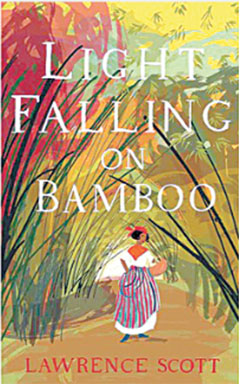|
Intermix.org.uk is a website for the benefit
of mixed-race families, individuals and anyone who feels they have a multiracial
identity and want to join us. Our mission is to offer a view of the mixed-race experience, highlighting icons, film, books, poetry, parenting techniques, celebrities, real lives and much more. Our online forums are a great place to meet others, ask questions, voice your opinions and keep in touch. Sign up for our monthly newsletter and delve into our pages. Want to join in? Become an Intermix member to take part: |
Light Falling On Bamboo
Lawrence Scott
 Tindal Street
Tindal Street
Price: £10.99
Lawrence Scott was born on a sugar plantation in Trinidad, and was a Benedictine monk in England before becoming a teacher and an extremely gifted writer. Moral dilemmas underpin much of his accomplished fiction. Aelred's Sin (2002) explores homoerotic love and Catholic attitudes to sexuality within the walls of a monastery. In Night Calypso (2004) he immersed the reader in the morally unsettling world of illicit relationships in a Trinidadian leper colony. With his third novel, Light Falling on Bamboo, he turns his attention to Trinidad's finest 19th-century painter, Michel Jean Cazabon (1813-1888). As little is known about Cazabon's life, Scott has considerable freedom to flesh him out and explore the moral implications of his art and relationships.
Cazabon was mixed race and spent much of his childhood and early adulthood in England and France. The novel opens in 1948, post-emancipation, with his return to Port of Spain to visit his dying beloved mother. With hostile siblings and a distant father who, as a "Free Coloured", had been a slave master, Cazabon turns to his half-sister and former lover, Josie, for solace. She was also once one of his father's slaves. Josie has kept herself for him despite his marriage and other sexual liaisons: she is jealous, possessive, moody, steadfast, the limitations of her life in domestic service contrasting with the rich possibilities of his artistic one.
Soon Cazabon is introduced to high society by a young Englishman he befriends and teaches to paint. True to real life, the governor, Lord Harris, becomes his biggest patron, commissioning paintings of his home and surroundings. William Hardin Burnley, another historical figure and the island's richest plantation owner, known for his cruelty to slaves, also becomes a patron. Thus Cazabon finds himself mingling with the island's elite, and has to negotiate its expectations, boundaries, prejudices and protocols. To earn a living as an artist, he has to produce a romanticised, idealised, sanitised vision of the colony. Cazabon obliges, mindful of a training that instructed: "Art does not preach a sermon." Except it does, through omission: absent from his paintings are portrayals of the daily suffering and struggle for the majority of the population.
Scott's engagement with this debate is at the heart of the novel, although it is contradictory. Cazabon lives for his art, yet he can only enjoy success if he is complicit in the colonial enterprise. In this unequal, racially hierarchical society, his moral ambiguity is a means of survival. On the one hand, he believes himself to be subtly subversive, affording his mixed-race and black sitters a dignity through portraiture. On the other: "A group of workers, Africans and some of the new Indians, passed them … black as the soot from the fields of burned cane which they had been cutting and loading on to carts. Michel Jean thought of how he had erased the cruelty of this labour from his paintings." His outspoken French wife berates him: "You made their empire seem benign and just."
Cazabon's relationships with women, all of whom are bound by society's sexual mores and injustices, are also problematic. His betrayed wife, Louise, doesn't know the half of it about her roving husband. The sexual vulnerability of women is typified in the character of Augusta, the intoxicating daughter of a former slave, with whom Cazabon dallies. She lives under the patronage of Hardin Burnley but seeks to escape the great bulk of her "master's" weight at night by the best means necessary – another rich man.
Scott imagines a sympathetic Cazabon who is possibly more tortured over his peccadilloes than would be true of the time, but the novel is written in a magnificent prose style that matches the art it describes.
Thank you to Bernardine Evaristo for this review, first published in The Guardian
